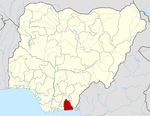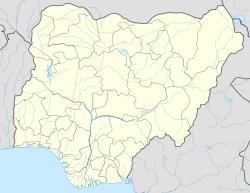- Oron people
-
Oron Coordinates: 5°3′N 7°56′E / 5.05°N 7.933°ECoordinates: 5°3′N 7°56′E / 5.05°N 7.933°E State Akwa Ibom Government - Governor Godswill Obot Akpabio Population (2005) - City 246,000 - Metro 403,242 estimated Time zone WAT (UTC+1) The Oron people are comprised in five Local Government Areas (LGAs) in Akwa Ibom State, Nigeria. The Oron are the third largest ethnic group in the state, and Bakassi LGA in Cross River State. The five Local Councils in Akwa Ibom are Oron, Udung-Uko, Mbo, Urue-Offong/Oruko, and Okobo. The Oron people, popularly called 'Oro Ukpabang' or 'Akpakip Oro' by its indigenes, are made up up of several clans. There are nine clans called Afaha. They are namely: Afaha Okpo, Afaha Ukwong, Ebughu, Afaha Ibighi, Effiat, Afaha Ubodung, Etta, Afaha Oki-uso, and Afaha Idua (Iluhe). However, the geopolitical restructuring of the state and local government creation has seen the Oron nation being fragmented politically into two states of Nigeria, namely Cross River and Akwa Ibom state. There are five Oron Local Government Areas in Akwa Ibom State and one Local Government in Cross River State.
Oron town is the third largest city in Akwa Ibom state after Uyo and Eket. It has a population of around 250,000 people living within the city. Lying on the Cross River, Oron has a seaport and a Maritime Academy which is soon to become a nautical university. The predominant occupation is fishing and farming.
Contents
History
Oron was in existence in the pre-colonial period in Nigeria and was formerly a part of the province called the South-Eastern state. Natives of this area speak the dialect also known as Oron. Most Oron people also speak and understand the Efik language fluently. The Oron also have some dialectical similarities with the Ibibio and Annang people, hence their communication in Ibibio and Annang languages is very proficient.
It has been posited that the Oron people are of many Bantu ethnic origins which migrated from North-Eastern Africa around Ethiopia (Abyssinia) to Central Africa (around the present-day Congo Republic and Democratic Republic of Congo) and through the southern Cameroons to the present-day Niger Delta region of Southern Nigeria. They came by sea, on rafts made of wood, bamboos and rope. The migration took place in about the 13th century. The people grouped into Oron Ukpabang and Idua.
The migration history of the Oron people is closely related to that of the Efik Eburutu people. In fact, the Efik people regard and treat the Oron people as part of the larger Oron and Calabar people because of their common Bantu origin, culture, and tradition. Some quarters also relate Oron and Efik people with Eket (Ekid) people because of their very close dialect and mutual relationship. This was most especially in the days of the Okpo Ekid of Oron. But in modern days, the Oron people avoid such history, but they own up to the fact that the Ibono, who dwell among the Ekids share similar ancestral history with them. One controversy says that the relationship of Oron with Eket is said to have gone sour when the Eket under the regime of Brigadier General U.J. Esuene declared and agreed to be called a subgroup of the Ibibio nation to gain political relevance and advantage. U.J. Esuene was also said to have denied the Oron people of the opportunity to site the Exxon Mobile's first terminal in Mbo and Effiat Oro areas of Oron. Another common controversy that describes the worsened relationship between Oron and Eket is the accusation that General Esuene was the one who ordered the bombing of Urue Oruko, a region at the heart of Oron where several millions of Oron people (mostly traders and women) were killed during the Nigerian Civil War in the late 1960s. This unfortunate event in Oron has been observed to be the most tragic in the history of the Nigerian Civil War.
Geography
Oron is found in the flood plain of South Eastern Nigeria, with the land mainly intersected by numerous streams and tributaries flowing into Cross River. The entire coastline stretches from Uya Oron to Udung Uko.
Oron is in the tropical region and has a uniformly high temperature all the year round. The two main seasons are the dry which spans between October and April and wet season which starts around May and ends in September. There are also two prevailing winds – the South-West onshore winds which brings heavy rains and the North- East trade winds blowing across the Sahara Desert, which brings in the dry season.
Natural Resources
Oron is rich in oil and natural gas. Most of its oil reserves are off-shore. There are 25 corked oil wells. Oron is presently rated as having one of the highest supplies of natural gas deposits in sub-Saharan Africa with large amounts of untapped natural gas and oil at Ukpata, Udung Okung, and Edik Ekpu.
The region is extremely fertile and is known for its topographical Oil Palm Belt, tropical rainforest, swamps, and beaches. The mangrove forests also provide timber and raw materials for medicinal purposes. There are also deposits of solid minerals such as iron, free silica or glass sand and gravel. Seafoods such as crayfish, snipers, oyster and periwinkle abound richly in all coastal areas.
Education
Oron people were among the earliest to encounter Western education in West Africa. This is most evident with the establishment of the Hope Waddell Training Institute, Calabar in 1895 and the Methodist Boys High School, Oron in 1905. These schools are the oldest in the history of Nigeria and attracted students from all over Western and Central Africa.
Politics
With a well formidable socio-cultural group called the Oron Union founded in 1925, the Oron people became one of the most formidable and vocal groups in the South-South region of Nigeria , hence one of the three political forces in the present day Akwa Ibom State.
Oron became a Division in August 1970 and in 1976, was made a local government area. However, following the local government creation exercise of the federal government in 1989, Oron was split into 3 Local Government Areas of Mbo, Oron and Okobo. Again in September 1991, Urue Offong/Oruko Local Government Area was carved out of Oron Local Government Area. Finally in December 1996, Udung Uko Local Government Area was further carved out of Oron.
Currently, the Oron people are still struggling in their attempts to properly place the Oron union in a position to control their political interests in the state. In the past, the Oron Union has put up such structures as the CWC (Central Working Committee), Esumbuke Oro, and quite recently, the Oron Think-Tank, and many others to address certain issues. There has been little success with these structures, when compared to the political expectation of the average Oron person within the state and Nigeria.
Kingship
Traditionally, the Oron people have one king that rules over the land. He is known as the 'Ahta Oro'. The Ahta has all the Ofong (Ivong or Ifong) afaha and the paramount rulers as members of his traditional rulers council. Some high chiefs (for example, Ikpoto, Akpha and Okete Okete) are also recognized by the Ahta's council. The President-General of the Oron Union worldwide is regarded as the administrative head of the Oron nation and second-in-command at the Ahta's traditional rulers council.
Culture and Tradition
The Oron people have a unique culture and tradition. The Ekpe Society is used throughout Oron Land as the authority. There are other traditional cults and societies which include the Ekpo, Abang, Edeme Awan Nkwho, Ekon, Afikegit, Konkoma, Mbok, Ababa, Nnabo,and many others. All these societies, in addition to the unique hospitality of the Oron people, their arts, rich diet, Oil and Gas minerals, have been known to attract tourism and commerce to the area and Akwa Ibom state in general.
The Oron people have a very colourful mode of traditional dressing, especially with an Iyara (which is red in colour). The red Iyara is usually worn with a white tailored traditional shirt and a wrapper (large fabric wrapped around the waist) to match. This wrapper is commonly worn by several peoples of southern Nigeria. Sometimes it can be combined with the rich Efik native piece of cloth (tie), usually a colourful silk material. Recently the Oron people have been known to tie a piece of cloth usually in form of a handkerchief on the neck. This cloth could be white or coloured depending on the user and his combination intent. A blend of the neck handkerchief and the Efik native tie is also very common among the Oron people. Generally, apart from the distinction of the red Iyara, it is not easy to distinguish an Oron man or woman from an Efik person in terms of attire and the culture. It is also relatively difficult to see any other native attire within the shores of Africa and perhaps even the world that competes favourably with that of the Oron and the Efik people. These attires are also sometimes used by the Ibibio and Annang groups of Akwa Ibom state; except that the Annang and Ibibio people will not put on the red Iyara of Oron people because of its political implications and consequence.
Language and Culture
The people have a distinct Oro language, although many speak and understand the Ibibio language. Oron has a rich culture expressed in songs, folklore and dances. The first National Museum east of the Niger and the Maritime Academy of Nigeria are located in Oron.
International Airport
The Ibom International Airport is situated in Oron nation (Okobo LGA). The administrative office of the airport is located in the nearby Uruan, Uyo LGA. Uruan is said to have an ancestral relationship with the Oron group, just like the Efiks, Ibono, Eastern Obolo, and Andoni groups.
The city is currently witnessing massive infrastructural development such as the dualization of Oron-Eket Highway, construction of various intercity roads, health centres, schools, and housing estate projects to give the ancient city a facelift.
External links
- http://wikimapia.org/#lat=4.7904562&lon=8.2359695&z=13&l=0&m=a&v=2
- http://en.wikipedia.org/wiki/Oron_(state)
Ethnic groups in Nigeria Annang · Atyap · Aulliminden · Berom · Edo · Buduma · Defaka · Djerma · Ebira · Efik · Eket · Ekoi · Eleme · Esan · Etsakor · Fon · Fula · Goemai · Gwari · Hausa · Ibibio · Idoma · Igala · Igbo · Ijaw · Isoko · Itsekiri · Jukun · Kamuku · Kanuri · Kilba · Kirdi · Kofyar · Kuteb · Longuda · Mumuye · Nupe · Ogoni · Saro · Tarok · Tiv · Urhobo · Yoruba
 Akwa Ibom State
Akwa Ibom StateState capital: Uyo LGAs Abak · Eastern Obolo · Eket · Esit Eket · Essien Udim · Etim Ekpo · Etinan · Ibeno · Ibesikpo Asutan · Ibiono-Ibom · Ika · Ikono · Ikot-Abasi · Ikot Ekpene · Ini · Itu · Mbo · Mkpat-Enin · Nsit-Atai · Nsit-Ibom · Nsit-Ubium · Obot-Akara · Okobo · Onna · Oron · Oruk-Anam · Udung-Uko · Ukanafun · Uruan · Urue-Offong/Oruko · Uyo
 Categories:
Categories:- Ethnic groups in Nigeria
- Akwa Ibom State
- Cross River (Nigeria)
Wikimedia Foundation. 2010.

